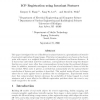Free Online Productivity Tools
i2Speak
i2Symbol
i2OCR
iTex2Img
iWeb2Print
iWeb2Shot
i2Type
iPdf2Split
iPdf2Merge
i2Bopomofo
i2Arabic
i2Style
i2Image
i2PDF
iLatex2Rtf
Sci2ools
PAMI
2002
2002
ICP Registration Using Invariant Features
This paper investigates the use of Euclidean invariant features in a generalization of iterative closest point registration of range images. Pointwisecorrespondences are chosen as the closest point with respect to a weighted linear combination of positional and feature distances. It is shown that under ideal noise-free conditions, correspondences formed using this distance function are correct more often than correspondences formed using the positional distance alone. In addition, monotonic convergence to at least a local minimum is shown to hold for this method. When noise is present, a method that automatically sets the optimal relative contribution of features and positions is described. This method trades o error in feature values due to noise against error in positions due to misalignment. Experimental results show that using invariant features decreases the probability of being trapped in a local minimum, and is most e ective for di cult registration problems where the scene is ...
| Added | 23 Dec 2010 |
| Updated | 23 Dec 2010 |
| Type | Journal |
| Year | 2002 |
| Where | PAMI |
| Authors | Gregory C. Sharp, Sang Wook Lee, David K. Wehe |
Comments (0)

